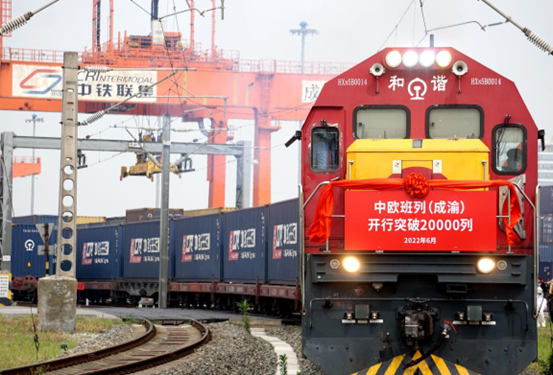By Qiu Haifeng, People's Daily
A cargo train, fully loaded with electronic products, mechanical parts and daily necessities, which departed from southwest China's Chongqing municipality on June 23, and arrived in Germany's Duisburg on July 11.
This marked the 10,000th trip made by China-Europe freight trains operated by the China-Europe Railway Express (Chongqing), the first of its kind in China.
China-Europe freight trains have bucked the trend and witnessed rapid growth this year. They offer a strong support for the global industrial and supply chains with stable, reliable and efficient logistics services despite impeded global circulation and insufficient transport capacity, making positive contributions to stabilizing global trade and promoting global economic recovery.

On July 7, a China-Europe freight train loaded with steels and other cargos departed from Huangshi, central China's Hubei province for Duisburg. As the first cargo route linking the two cities, the Huangshi-Duisburg cargo line has opened a new land channel for economic and trade exchanges between them and is able to transport nearly 200,000 tons of cargos on an annual basis.
"We shipped 500 tons of special steels via the train. Compared with maritime transport, it saved us nearly a month. Our delivery has become much more efficient," said Li Jie, head of the foreign trade department of a special steel manufacturer.
According to Li, the route reduces not only the time of transport, but also transhipment, which lowers both logistics cost and the risk of cargo damage, and at the same time increases enterprises' competitiveness.
After years of development, China-Europe freight trains have maintained a sound momentum for regular and large-scale operation.
Statistics indicate that China-Europe freight trains made 15,183 trips in 2021, up from 1,702 in 2016, with an annual average growth of 55 percent. The value of goods transported by the cargo service skyrocketed from $8 billion in to $74.9 billion during the same period.

In the first half of this year, 7,473 trips were made by the cargo service, carrying 720,000 twenty-foot equivalent units. In each of the past 26 months, over 1,000 trips were made by China-Europe freight trains.
At present, the cargo service extends to more than 180 cities in some 20 European countries, forming an extensive Eurasian logistics network.
The development of China-Europe freight trains is mirrored by not only the growing cargo volume, but also a boom in the quality of the logistics services they provide.
There has been a prominent increase in the number of loaded containers carried by China-Europe freight trains, and the numbers of departing and returning trips are getting more balanced.
According to statistics, the overall proportion of fully loaded containers carried by China-Europe freight trains increased from 77.2 percent in 2016 to 98.1 percent in 2021, and the figure has been maintained at around 98 percent for both departing and returning trips since this year.
Mobile phones, laptops and other electronics products made up the majority of cargos carried by China-Europe freight trains when the cargo service was just launched. Today, the service transports over 50,000 types of products, including auto parts, automobiles, chemicals, electromechanical equipment, food, alcohol and wood.

Last year, the ratio of returning trains to departing trains increased 3.8 percentage points to 81.5 percent, which was more than 30 percentage points higher than that in 2016. The numbers of returning and departing trips between major hubs have been basically equal this year.
Despite COVID-19 resurgences, China-Europe freight trains maintained safe and stable operation, sending Chinese anti-pandemic materials to the European countries and building a "bridge of life." Last year, the cargo service carried 4.23 million anti-pandemic items weighing 29,000 tons. The two figures had hit 14.1 million and 108,000, respectively, as of the end of April this year.
"After years of development, during which the cargo service has withstood the test of COVID-19 and the changing international situation, the value and economic significance of China-Europe freight trains have been widely recognized by countries and regions along the rail routes," said Li Dawei, a researcher with the Institute of International Economic Research at the Chinese Academy of Macroeconomic Research. He said the cargo service is becoming a major trade channel co-constructed and co-protected by countries and regions along its route.


